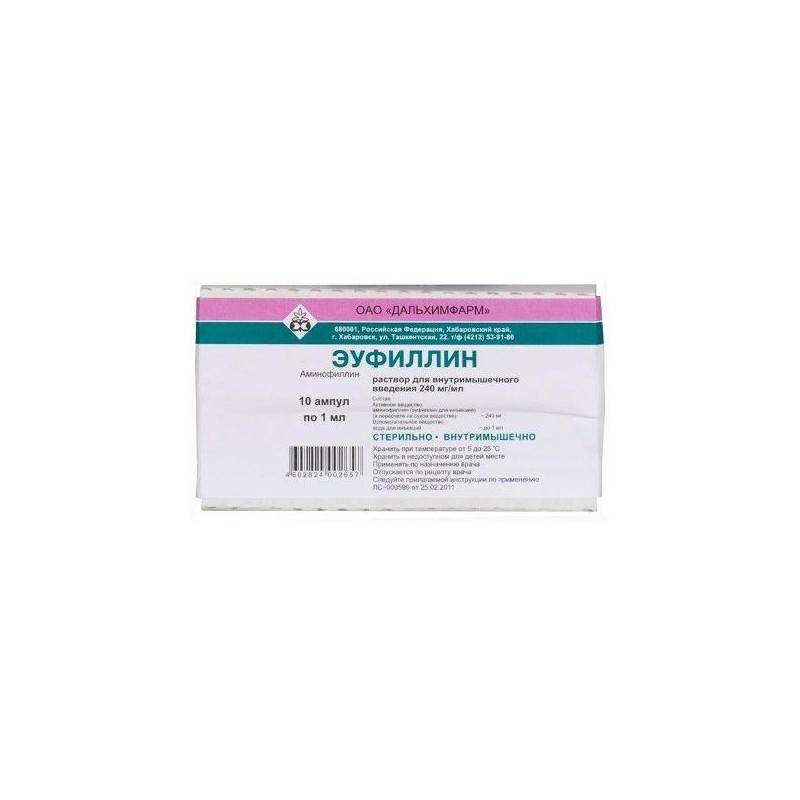



 All payments are encrypted via SSL
All payments are encrypted via SSL
 Full Refund if you haven't received your order
Full Refund if you haven't received your order
Solution for intravenous administration
1 ml of solution for intravenous administration contains: aminophylline 24 mg, incl. theophylline 19.2 mg, ethylene diamine 4.8 mg.
Excipients: water for injections.
10 amp. on 10 ml.
Euphyllin is a bronchodilator drug.
Aminophylline is a mixture of 80% theophylline (1,3-dimethylxanthine) and 20% ethylenediamine (1,2-ethylenediamine), which facilitates its solubility and improves absorption.
The drug inhibits phosphodiesterase and increases the accumulation of c-AMP in tissues, blocks adenosine receptors, has the ability to inhibit the transport of Calcium ions through the channels of cell membranes. Relaxes the muscles of the bronchi, relieves bronchospasm. Several dilates the vessels of the heart, brain, kidneys, is a peripheral vasodilator. It has a moderate diuretic effect. Inhibits platelet aggregation.
It has a stimulating effect on the respiratory center, increases the frequency and strength of heart contractions.
Chronic obstructive bronchitis, bronchial asthma (a drug of choice in patients with physical stress asthma and as an additional remedy for other forms), asthmatic status (adjunctive therapy), pulmonary emphysema, neonatal apnea (condition,characterized by periods of lack of breath for 15 seconds and accompanied by cyanosis and bradycardia), Cheyne-Stokes breathing.
Hypersensitivity, including xanthine derivatives (caffeine, Pentoxifylline, theobromine), arrhythmia, hypertension, pathology infarction, myocardial infarction, heart failure, acute and chronic (acute phase), gastritis, gastric ulcer and duodenal ulcer, prostate adenoma, diarrhea, cystic fibrous mastopathy, alcoholism, pulmonary heart, fever, hypoxemia, respiratory infections, liver dysfunction, hyperthyroidism, chronic and acute renal failure, brary syndrome, hypernatremia, rectal diseases, breastfeeding.
2.4% solution is injected into / in the jet.
Obstructive pulmonary disease
In the acute phase of adults:
The initial dose is 5-6 mg / kg (with a further increase in the dosage of the drug for every 0.5 mg / kg there is an increase in the concentration of aminophylline in the blood by 1 mcg / ml) it must be borne in mind that the concentration of aminophylline in the blood serum should not exceed 20 mcg / ml (possible development of side effects).
Maintenance dose - for smokers 4 mg / kg every 6 hours for non-smokers and patients with liver pathology - 2 mg / kg every 8 hours for children, the initial dose is 5-6 mg / kg. Supportive (in mg / kg) - calculated by the formula: children up to 6 months - 0.07 x age in weeks + 1.7 every 8 hours,children from 6 months to 1 year - 0.05 x age in weeks + 1.25 every 6 hours, from 1 year to 9 years old - 5 mg / kg every 6 hours, from 9 to 12 years old - 4 mg / kg every 6 h, from 12 to 16 years - 3 mg / kg every 6 hours.
Out of aggravation to adults
The initial dose is 6-8 mg / kg / day (maximum 400 mg / day), divided into 3-4 doses with good tolerance, a further dose increase is possible by 25% every 2-3 days up to a maximum of 13 mg / kg / day (900 mg / kg / day).
Out of aggravation to children
The initial dose - 16 mg / kg / day (maximum 400 mg / day), divided into 3-4 doses with good tolerability may increase the dose by 25% every 2-3 days - up to the maximum daily, which is for the age up to 1 year - 0.3 x age in weeks + 8.0, from 1 year to 9 years - 22 mg / kg, from 9 to 12 years - 20 mg / kg, from 12 to 16 years - 18 mg / kg, over 16 years - 13 mg / kg.
With newborn apnea
The initial dose is 5 mg / kg (administered by nasogastric tube).
Maintenance dose - 2 mg / kg, in 2 doses. The course of treatment is several weeks, in rare cases - months.
Are possible: lack of appetite, nausea, headache, tachycardia, anxiety, dizziness, vomiting, cardiac arrhythmias, albuminuria, hematuria, allergic reactions in the form of skin rash.
Seldom: convulsions, aggravation of peptic ulcer, hypoglycemia.
The drug is prescribed with caution to patients with a fever of unknown origin, the elderly.
Euphyllin can raise level of uric acid in urine.
When prescribing the drug during periods of pregnancy and lactation, it is necessary to compare the expected benefits to the mother and the potential risk to the fetus ornewborn baby.
Use caution when consuming large amounts of caffeine-containing foods or beverages during treatment.
Before parenteral administration, the solution must be heated to body temperature.
Pharmacodynamic interaction
With simultaneous use with eufillinom bronchodilating effect of terbutaline and Salbutamol increases. Simultaneous use of Euphyllin with beta-blockers can cause bronchospasm.
Pharmacokinetic interaction
Cimetidine, Erythromycin, influenza vaccine and oral contraceptives enhance the effect of Euphyllin, increasing its concentration in the patient's blood plasma.
With simultaneous appointment with Carbamazepine, phenytoin, rifampicin, the concentration of Euphyllin in the blood plasma decreases. Nicotine activates metabolism and elimination of Euphyllin.
With simultaneous use of Euphyllin increases the excretion of lithium.
In a dry dark place.
Euphyllin